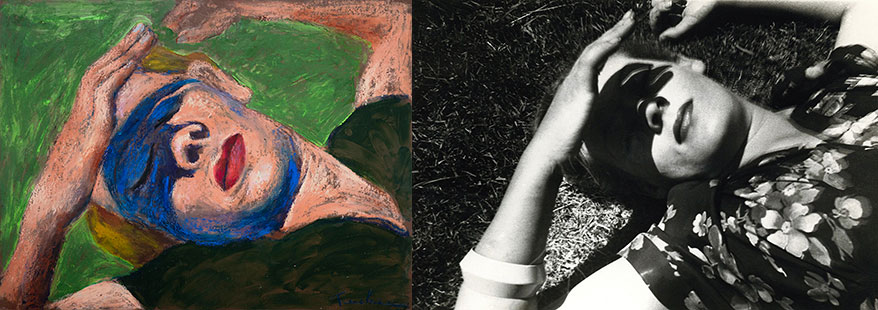 Exploring how dress, photography and portraiture are used to define and redefine personal and cultural identity, Monash Gallery of Art presents Fashioning black identity: Africa and the African diaspora and Dressing up: clothing and camera. These exhibitions will be shown alongside The Tucker portraits which explores how Australian modernist artist Albert Tucker embedded photography within his practice.
Exploring how dress, photography and portraiture are used to define and redefine personal and cultural identity, Monash Gallery of Art presents Fashioning black identity: Africa and the African diaspora and Dressing up: clothing and camera. These exhibitions will be shown alongside The Tucker portraits which explores how Australian modernist artist Albert Tucker embedded photography within his practice.
On display from the Cairns Art Gallery, Fashioning black identity: Africa and the African diaspora deals with the ways in which contemporary black African artists are using fashion, photography and portraiture to redefine personal and cultural identity.
“Drawing upon the tradition of African studio photography, the artists in the exhibition use portraiture, fashion, textiles and styling to raise questions around identity, power and history,” says Julietta Park, Senior Curator, Cairns Art Gallery. “Through portraiture the artists represent themselves and others as they want to be seen, contesting past discourses and engaging with new discourses around race and identity.”
The exhibition features works by seven prominent artists from Africa and the African diaspora who use photography and different spatial, corporal and temporal reference points as devices to explore and unpack perceptions of race and being. Artists on display include Jojo Abot, Leonce Raphael Agbodjelou, Atong Atem, Delphine Diallo, Omar Victor Diop, Seydou Keïta, Namsa Leuba
For Gareth Syvret’s curatorial debut at MGA, Dressing up: clothing and camera showcases a suite of photographs from the MGA Collection that imagine dress as the nexus of selfhood. Photography and dress are forever entwined; from its inception in the 1840s one of photography’s main objectives has been the making of portraits. Clothing has been imaged by photographers ever since.
The exhibition draws together photographs that feature dress or clothing as a significant element in their making. Some of the photographers included have produced works with documentary intent. For many, a classification of their practice is not so clear cut. These artists photograph dress, clothing and the body to actively question appearances.
They use photography as a tactic for testing the nature of consumer culture, challenging social norms or protesting histories of colonisation and discrimination. Shaping and shaped by the individual, our clothes can conceal, reveal and transform who we are. Like the photographs in this exhibition they are the bearers of memory, emotion and time.
“Dress and clothing are so much a part of the way people present themselves to the camera and this subject provides a strong theme through which to explore MGA’s extraordinary collection,” said Dr Gareth Syvret, MGA Associate Curator. “Some photographs in the exhibition are well known, others have not previously been shown. All are equally compelling in showing the way photographers record and manipulate dress to tell their stories.”
With paintings and rare photographs drawn from Albert Tucker’s personal archive, The Tucker portraits explores how an artist renowned for painting the evils of modern life used photography within his artistic practice, in particular in his portraiture. In 1939 Tucker acquired his first camera. From that moment on he began documenting his life and the people and places that meant so much to him.
His archive of photographs range from studies of people that he used as inspiration and source material for his paintings, through to incredibly rare and intimate portraits of his family and friends who today are recognised as leading protagonists in Australian modernism and the Heide circle.
These images explore the social, cultural and political life of Australia throughout the 1930s to late 1990s. The exhibition showcases the original photographs alongside the paintings they inspired, with exclusive footage of Tucker speaking about his practice.
“It has been a great privilege working with the Albert and Barbara Tucker Foundation to draw together an exhibition that explores how photography was integral to the practice of Albert Tucker, one of Australia’s most important modernist artists, so well-known for his paintings of modern life,” said Anouska Phizacklea, MGA Gallery Director.
“Tucker’s relationship with photography changed over his career – he never thought of himself as a ‘photographer’, and while portraiture was important to his practice, he only produced a scarce few portrait paintings. This exhibition showcases rare photographs taken by Tucker, of himself and the people that meant so much to him, which he used to inspire his paintings”
“Tucker commented that he used portraiture as a way to try and reach back into the past and seize that period, and the people who comprise it and try to fix them … these people were part of my artistic life and human background … the important thing for me was to recreate their presence and fix them so that they would have some kind of immortality.”
Fashioning black identity: Africa and the African diaspora / Dressing up: clothing and camera / The Tucker Portraits
Monash Gallery of Art, 860 Ferntree Gully Road, Wheelers Hill
Exhibition continues to 9 February 2020
Free entry
For more information, visit: www.mga.org.au for details.
Image: Albert Tucker, Joy Hester, 1983. crayon and synthetic polymer paint on card, 31.0 x 41.0 cm / Albert Tucker, Joy Hester, Fitzroy Gardens, 1942. gelatin silver print, 10.4 x 15.8 cm – courtesy Albert and Barbara Tucker Foundation
